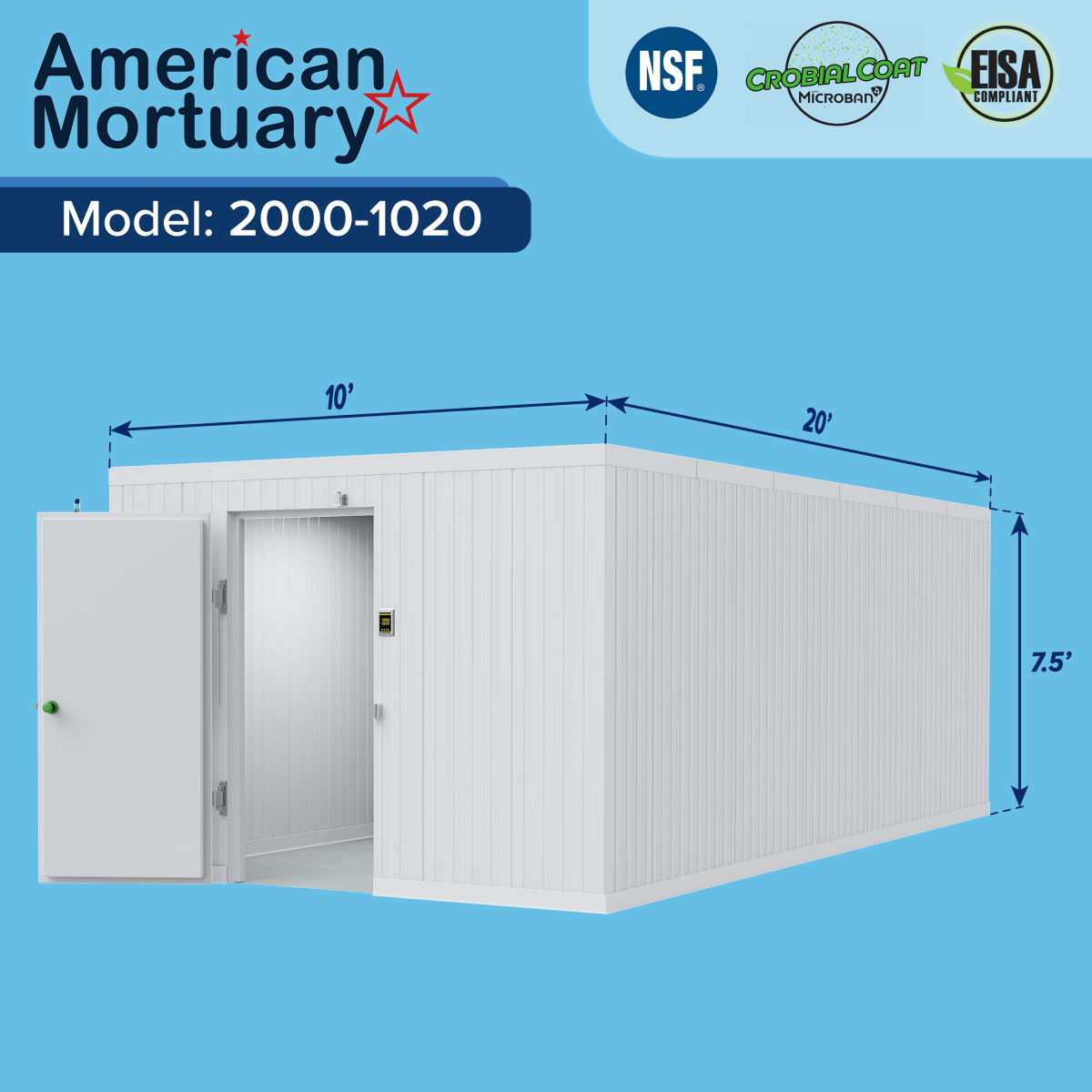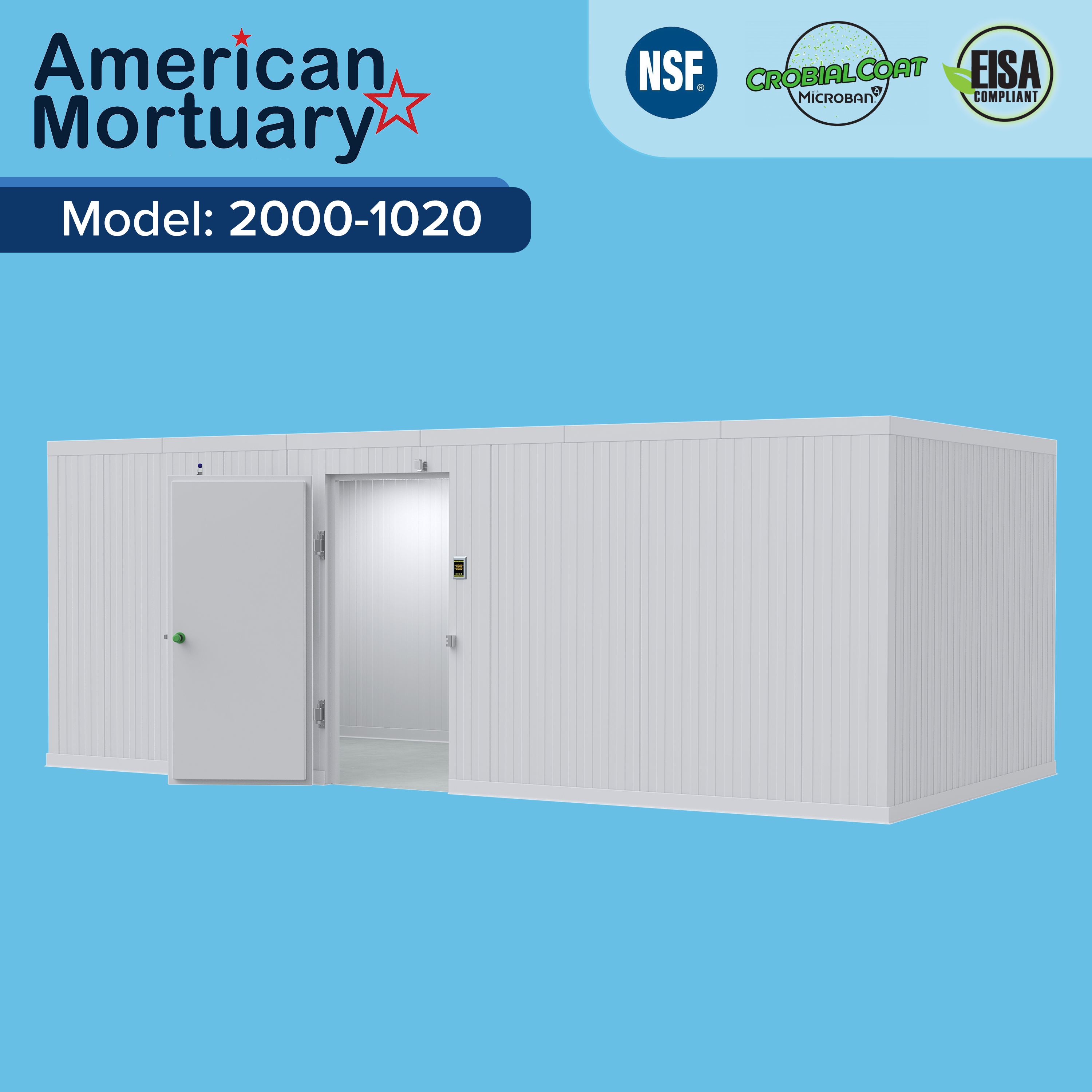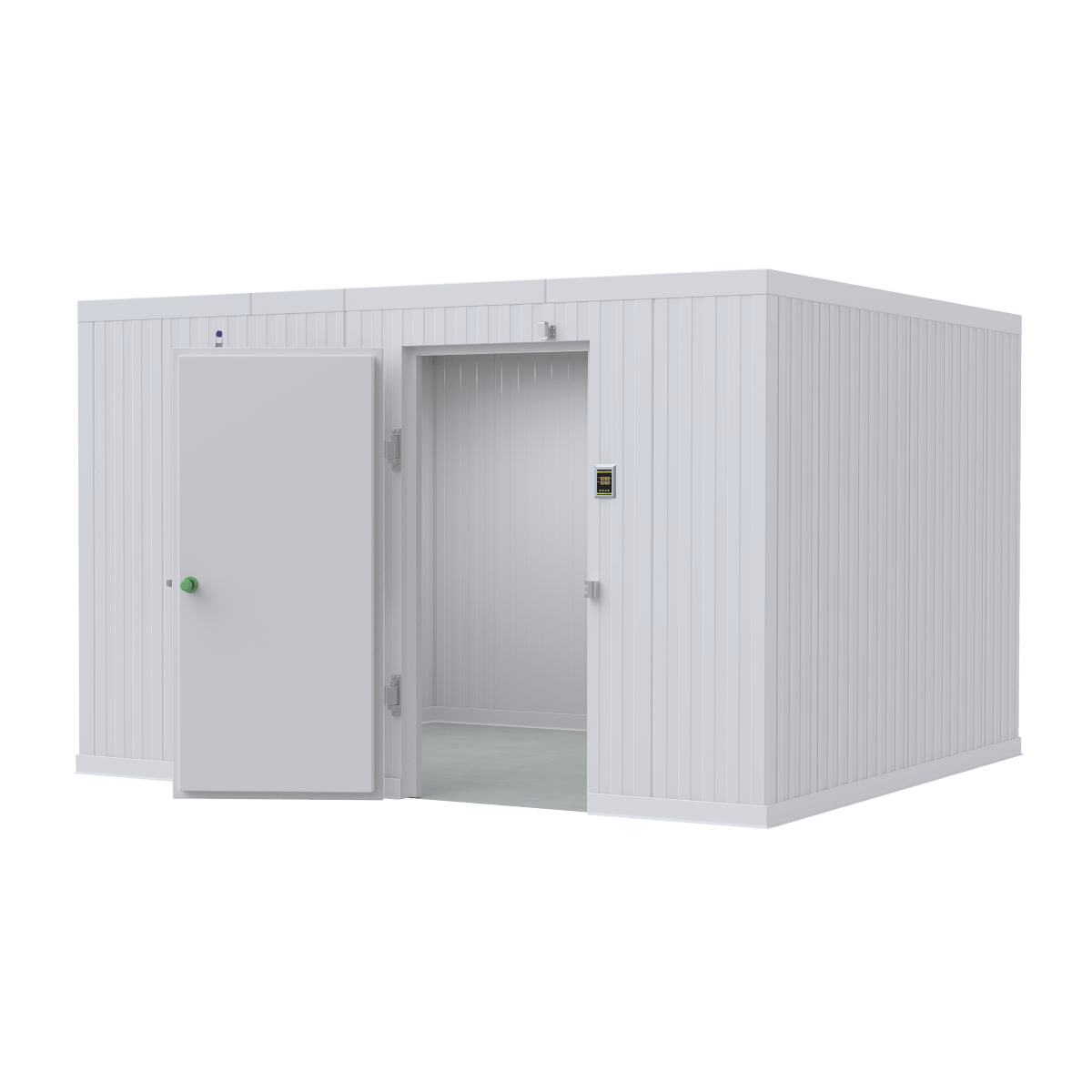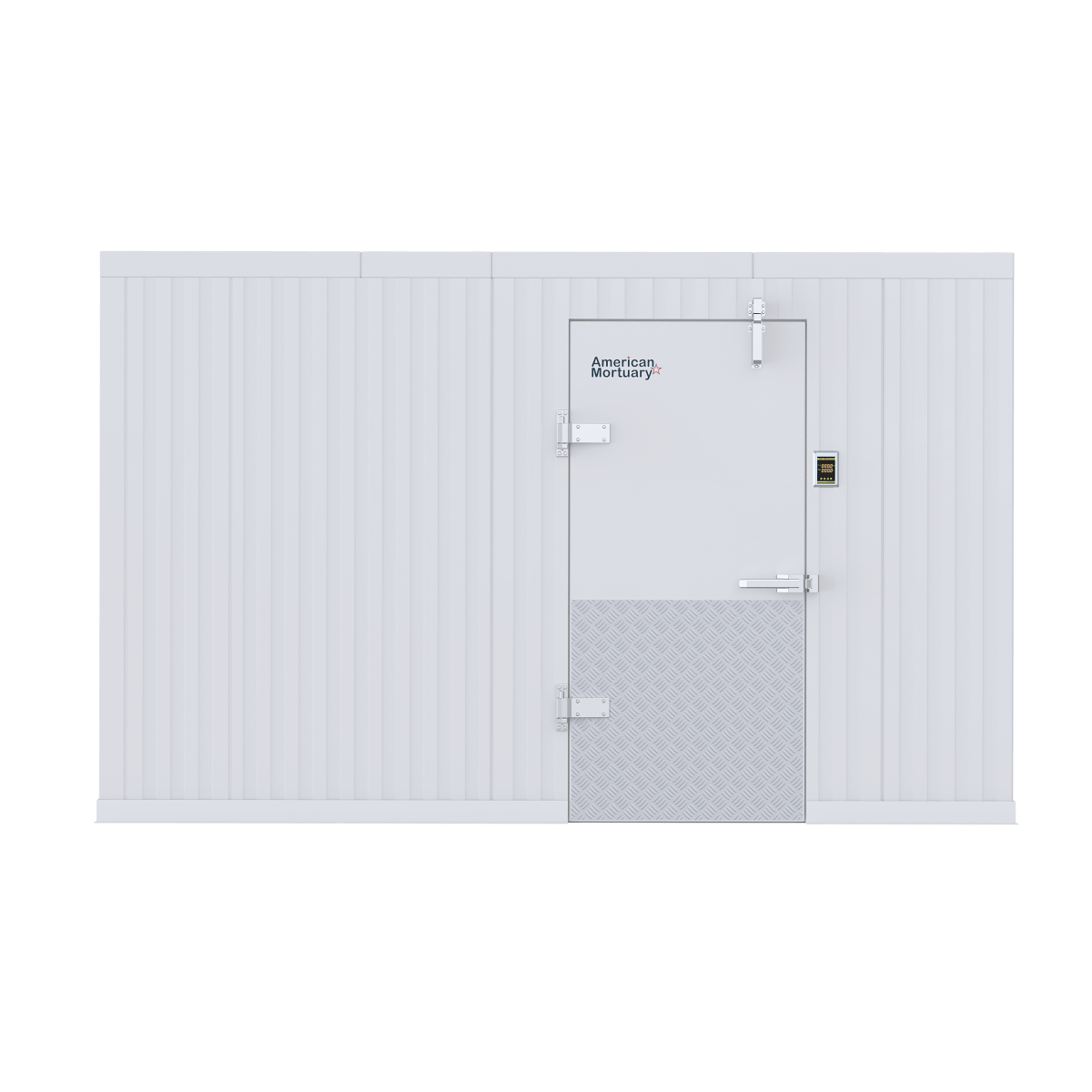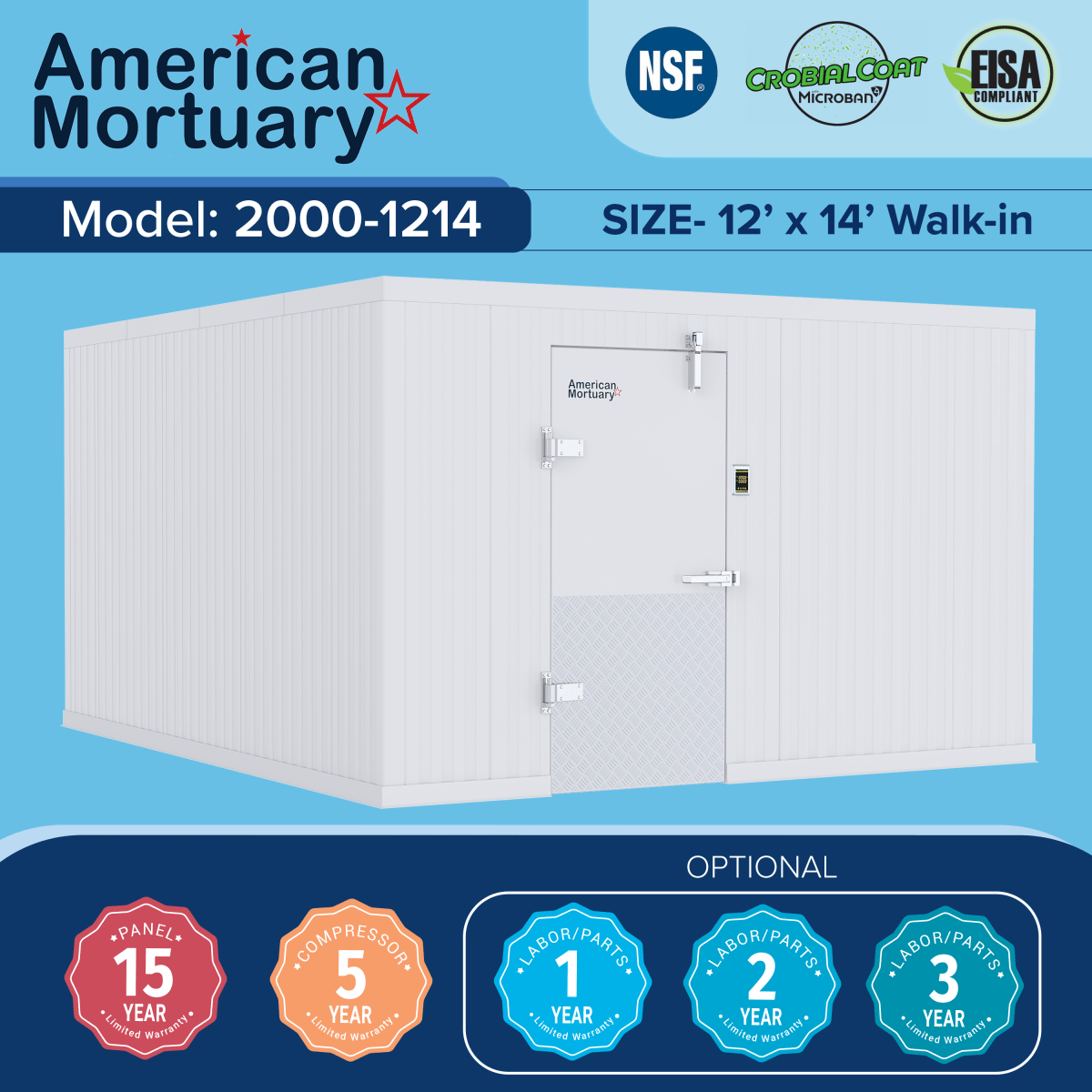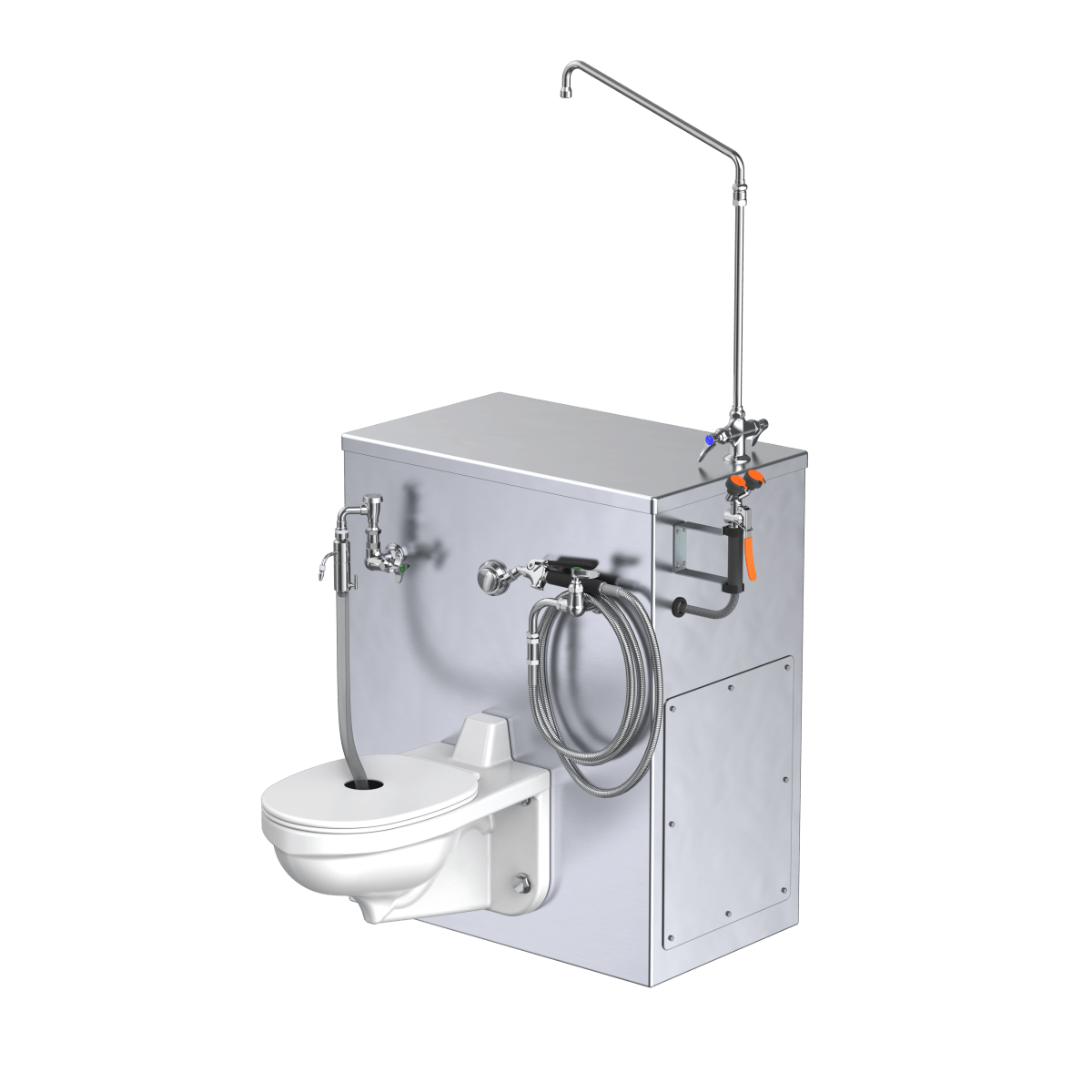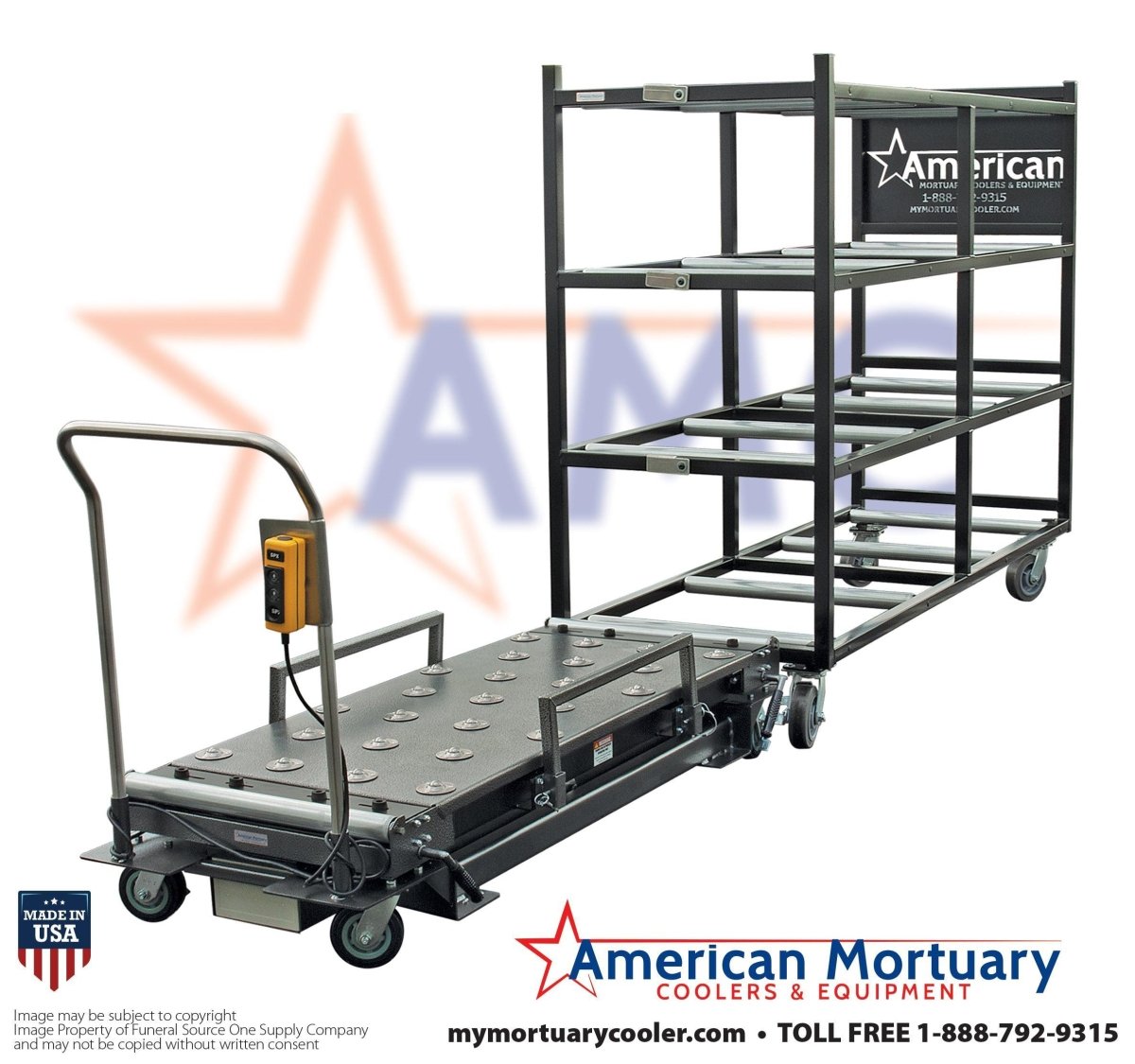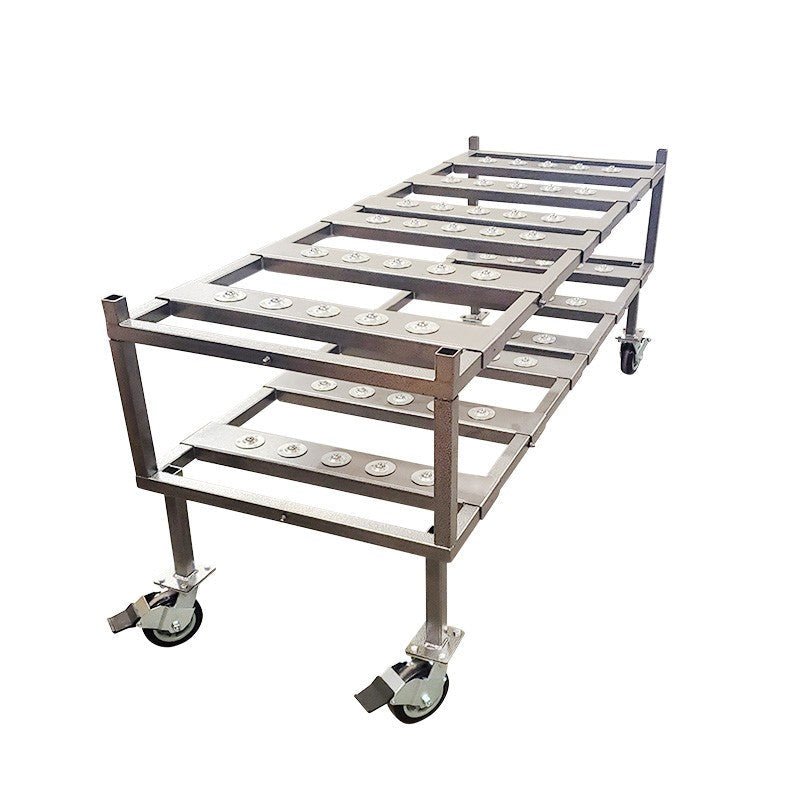Honoring Memories: Storing Ashes in a Urn
Storing ashes in a urn is an important step in the memorial process that requires both practical knowledge and emotional sensitivity. If you're looking for guidance on this process, here's what you need to know:
Quick Guide to Storing Ashes in a Urn:
- Choose the right size - Use the 1:1 rule (1 pound of body weight = 1 cubic inch of ashes)
- Gather supplies - Newspaper/towel, funnel, scissors, and optionally gloves
- Create a calm workspace - Use a flat, undisturbed surface
- Transfer carefully - Either pour directly or keep ashes in their bag
- Seal properly - Follow manufacturer instructions for secure closure
When a loved one passes, families face many challenging decisions. Choosing and filling an appropriate urn is one of these important tasks that helps create a meaningful memorial.
The process of placing cremated remains in an urn can feel overwhelming, but with proper guidance, it can become a respectful part of the grieving journey. As one funeral professional noted, "Breaking down a delicate task into clear, manageable steps helps families steer a difficult moment."
Most cremation urns are designed to safely contain the ashes of your loved one while providing a dignified resting place that reflects their personality and life. Whether you're selecting a metal urn with a marble finish, a wooden keepsake, or even a biodegradable option for an eco-friendly memorial, understanding the basics of ash storage will ensure you honor your loved one appropriately.
If the process feels too difficult emotionally, many funeral homes offer the service of transferring the ashes as a courtesy to families.

Basic ashes in a urn vocab:
Choosing the Right Urn for Ashes
Finding the perfect urn for your loved one's ashes is one of the most meaningful decisions you'll make in the memorial process. It's not just about having a container - it's about creating a lasting tribute that honors their memory in a way that feels right for your family.
When I speak with families about selecting urns, I always encourage them to take their time. This vessel will become a physical representation of your loved one's legacy, so it should reflect who they were in life.
Material Types
The material you choose for an urn affects not just how it looks, but how it will hold up over time and where it can be displayed.
Metal urns offer wonderful durability with classic elegance. Many families appreciate brass or bronze options for their timeless quality, while aluminum urns can provide similar beauty at a lighter weight. I've seen many families drawn to marble-painted aluminum urns that capture the beauty of ceramic but with added strength.
Wooden urns bring a natural warmth that many find comforting. Each piece of walnut, oak, or mahogany tells its own story through unique grain patterns. There's something deeply personal about a wooden urn - perhaps because trees themselves symbolize life and longevity.
Ceramic and porcelain urns showcase artistic elements through hand-painted designs or beautiful glazed finishes. While they require gentle handling, they can become stunning focal points that celebrate a colorful life.
Stone urns made from marble or granite offer substantial permanence. They carry a certain gravitas and timelessness that many families find appropriate for honoring their loved ones.
Glass urns transform remembrance into art with vibrant colors and patterns. Often handblown by skilled artisans, these pieces can capture light in ways that feel spiritually significant to many families.
Biodegradable materials provide an environmentally mindful option. These urns, made from materials like pressed paper, salt, sand, or plant fibers, return to the earth naturally when buried or placed in water.
Understanding Urn Sizes for Ashes in a Urn
Getting the right size is essential when selecting an urn. The industry standard follows a simple guideline: 1 pound of body weight equals approximately 1 cubic inch of cremated remains. This means someone who weighed 180 pounds in life will generally result in about 180 cubic inches of ashes in a urn.
As Laura, who recently purchased an urn, shared with us: "My family agreed, this is a beautiful urn. It was nicer than we expected, but most importantly, it was the right size for our needs."
Most standard adult urns hold about 200 cubic inches, but it's always better to choose an urn with a bit more capacity than you think you'll need. Cremated remains typically weigh between 5-10 pounds, representing about 3.5% of a person's original body weight.
| Person's Weight | Recommended Urn Capacity | Typical Urn Type |
|---|---|---|
| 20-50 lbs | 40-80 cubic inches | Child/Small Urn |
| 51-150 lbs | 120-180 cubic inches | Medium Adult Urn |
| 151-200 lbs | 180-220 cubic inches | Standard Adult Urn |
| 201+ lbs | 220+ cubic inches | Large Adult Urn |
| Companion Urns | 400+ cubic inches | For two people's remains |
| Keepsake Urns | 1-50 cubic inches | For a portion of remains |
Personalization Options
Adding personal touches to an urn can provide tremendous comfort. Many families tell me that personalizing their loved one's urn helped them feel connected to their memory in a tangible way.
You might consider engraving your loved one's name, important dates, or a meaningful quote. Some urns can be customized with artwork or photographs that capture special moments or interests. Many people choose urns with emblems representing hobbies, professions, or spiritual beliefs that were important to their loved one. Even selecting colors that were meaningful to the deceased can make the memorial more personal.
Jessica Burch, after purchasing a commemorative urn, told us: "Beautiful and crafted well. Looks like real ceramic. The engraving ensures our loved one's name and life will never be forgotten."
Types of Urns Available for Ashes
Beyond materials, urns come in specialized styles to meet different needs:
Display urns are designed to be visually appealing in your home. These often feature decorative elements that complement your décor while honoring your loved one with dignity.
Keepsake urns are smaller vessels that hold just a portion of ashes. These allow multiple family members to each keep a memorial close, which can be especially meaningful when loved ones live far apart.
Companion urns have space for two sets of remains, often chosen by couples who wish to remain together after death. These larger urns can be a beautiful symbol of enduring love.
Scattering urns are specifically designed for families planning ash dispersal ceremonies. They make the process more dignified and manageable during what can be an emotional moment.
Biodegradable urns offer an environmentally conscious option that naturally returns to the earth. These are increasingly popular for families concerned about environmental impact.

Outdoor urns require special consideration if you're planning to place them in a garden or memorial site. Look specifically for weather-resistant materials like type 316 stainless steel (which offers superior corrosion resistance), granite, or natural stone that can withstand the elements.
It's worth noting that not all urns can handle outdoor conditions. Some materials, like bronze, need annual maintenance with beeswax to preserve their appearance. Always verify that an urn is specifically engineered for outdoor exposure before placing it in an open-air setting.
Finding the right urn is a journey – one that honors both the person who has passed and provides comfort to those who remain. Take your time with this decision, and remember that the perfect urn is the one that feels right for your family and honors your loved one in a way that resonates with who they were.
Preparing to Place Ashes in a Urn
Transferring your loved one's ashes into their final resting place is a deeply personal moment. While it might seem overwhelming at first, with some thoughtful preparation, this process can become a meaningful part of your journey through grief.
Safety Precautions
Cremated remains aren't dangerous, but they are composed of very fine particles that can be a bit messy. Think of them as similar to fine beach sand or powder.
Wearing disposable gloves can help keep the process clean and may provide an emotional buffer that some people find helpful. If you're sensitive to dust or fine particles, a simple dust mask might make you more comfortable. I always recommend working in a well-ventilated space, but be careful about open windows or fans that could create drafts – the last thing you want is your loved one's ashes scattered unexpectedly across the room.
Keep a damp cloth or some tissues nearby for any quick cleanup that might be needed. The process isn't typically messy, but it's good to be prepared.
Required Tools
Before you begin, gather everything you'll need so you won't have to stop midway through this intimate process:
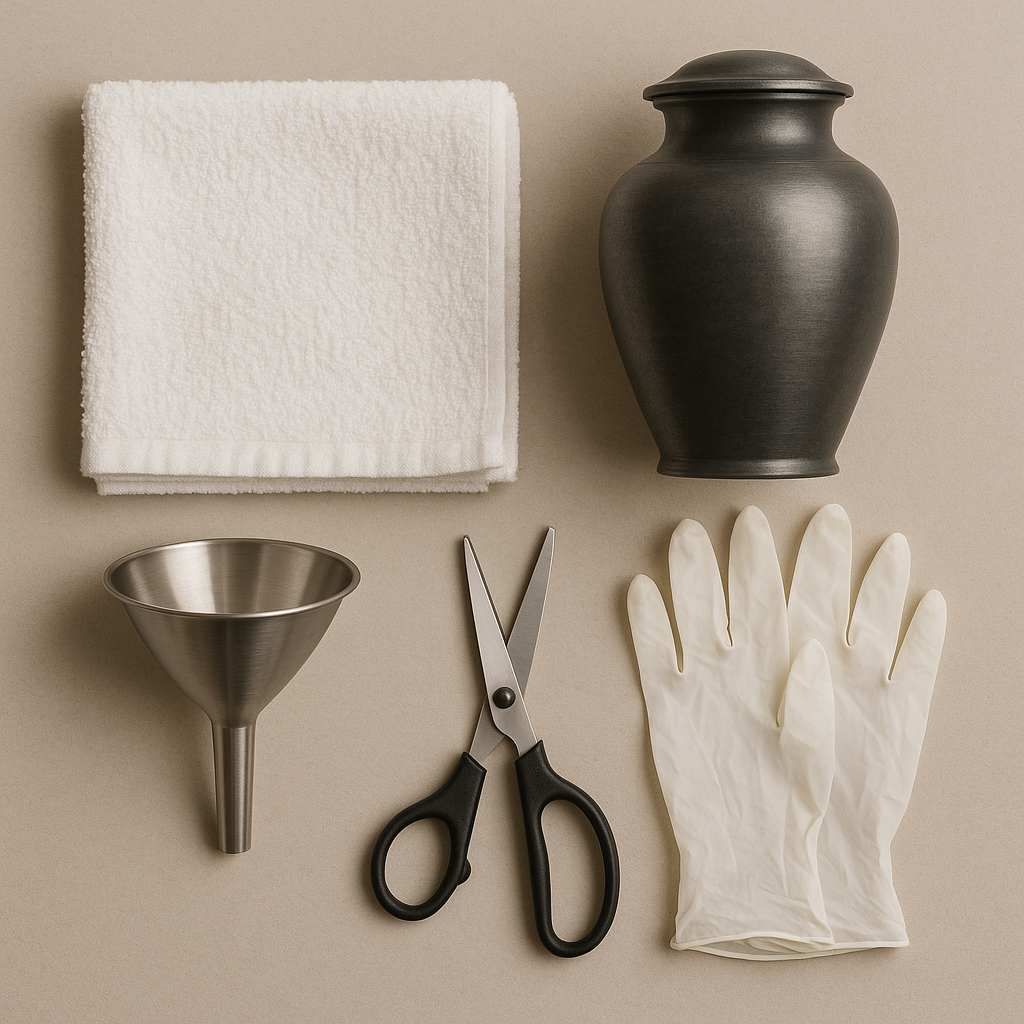
The essentials include the urn itself (with its closure system), a funnel (either purchased or homemade from stiff paper), and scissors to open the bag containing the ashes. You'll also want something to protect your work surface – a towel, newspaper, or sheet works perfectly.
Some people also find a small scoop helpful, though this is optional. If you're planning to permanently seal the urn, you might need appropriate adhesive, but check the manufacturer's recommendations first.
Emotional Preparedness
There's no right or wrong way to feel about handling your loved one's remains. Some find it therapeutic and meaningful, while others find it too difficult.
Consider whether you'd like someone beside you for support or if you'd prefer this to be a private moment. Choose a time when you won't be rushed or interrupted – this isn't something to squeeze between errands or meetings.
If you find yourself unable to complete this task, that's completely okay. Many funeral homes will transfer the ashes for you as a courtesy service. As one grief counselor I spoke with shared, "Handling the physical remains can be part of the healing process for some, while others may find it too overwhelming. Both responses are completely normal and valid."
Some families create a small ritual around this process – playing meaningful music, sharing memories, or saying a prayer. Others prefer a simple, quiet approach. Trust your instincts about what feels right for you and your family.
Steps to Transfer Ashes into a Urn
Creating Workspace
Start by finding a quiet, stable surface where you won't be disturbed. A dining table or desk works well, covered with a protective layer to catch any spills. Make sure you have good lighting so you can see clearly, and arrange all your supplies within easy reach.
This is a moment for mindfulness and respect. Many people find it helps to take a deep breath and center themselves before beginning.
Using a Funnel
The funnel method makes the transfer straightforward and reduces the chance of spills. Remove the lid from your urn and place your funnel securely in the opening. The cremated remains typically come in a sealed plastic bag with an identification tag – this tag is important and should stay with the ashes.
You have two main options for the transfer. You can pour the ashes through the funnel into the urn, which gives you the opportunity to see and connect with them. Alternatively, many people prefer to place the entire bag into the urn if it fits, which is cleaner and ensures all particles stay contained.
"Breaking down a delicate task into clear, manageable steps helps families steer a difficult moment. The transfer of ashes is not just a practical necessity but can become a meaningful ritual when approached with care and respect."
Sealing the Urn
Urns come with various closure systems. Threaded lids screw into place – just make sure the threads align properly and turn clockwise until secure. Plug-style closures press firmly into the opening, while bottom-opening urns often have a threaded plate that secures from underneath.
If you're considering permanently sealing the urn with adhesive, first think about whether you might need to open it in the future. Many families choose to keep the option open for dividing ashes later or for eventually scattering them.
Don't forget to keep the metal ID tag with the ashes during the transfer. This small disc contains important identifying information about your loved one's remains.
If you're planning to place portions of the ashes in keepsake urns or cremation jewelry, it's usually easiest to fill the main urn first, then carefully distribute smaller amounts to additional containers.
The process of placing ashes in a urn can be as unique as your relationship with your loved one. There's no single "right way" to approach this meaningful task – only what feels right for you and honors their memory in the way they would have appreciated.
Displaying Ashes in a Urn at Home
Creating a special place for your loved one's urn at home can be a meaningful way to keep their memory close. Many families find comfort in establishing a space where they can feel connected to those they've lost, turning an ordinary corner of their home into something truly special.
Placement Considerations
Finding the right spot for an urn is a personal decision that balances practicality with emotional significance. Most families look for a location that feels respectful yet accessible for quiet moments of reflection.
Accessibility matters – you'll want a place where family members can easily visit and spend time. Some prefer a private setting in a bedroom or study, while others choose a more central location like a living room where the presence of their loved one remains part of daily life.
Safety is naturally important too. Make sure to place the urn on a stable surface away from edges where it might be bumped or knocked over. This is especially crucial in homes with children, pets, or in areas with frequent movement.
Be mindful of environmental factors as well. Direct sunlight can fade certain materials over time, while high humidity might affect wooden urns. Consistent temperature is best for preserving both the urn and its contents.
Many families place urns at eye level or slightly above, creating a natural focal point that encourages reflection without dominating the space. Common locations include mantelpieces, dedicated shelves, bedside tables, or specially built niches that create a thoughtful memorial space.
Home Décor Integration
Today's urns come in so many styles that they can beautifully complement your existing décor rather than standing out as obviously funerary. Modern designs range from artistic sculptures to neat vessels that blend seamlessly with home furnishings.
Try choosing colors and materials that harmonize with your home's aesthetic. A wooden urn might feel at home in a space with other natural elements, while a sleek metal design might suit a more contemporary setting.
Some families create a small memorial vignette around the urn with photographs, meaningful mementos, or small keepsakes that tell a story about their loved one's life. Fresh or dried flowers, a special candle, or meaningful books can make the space feel warm and personal.
"We created a small shelf with Mom's urn, her favorite novel, and a photo from her garden," shares Maria, who keeps her mother's ashes in her living room. "It doesn't feel somber – it feels like she's still part of our home in a way that brings us comfort."
You might also consider seasonal touches – perhaps adding holiday decorations or changing elements that reflect the passing seasons. This can be a thoughtful way to include your loved one in family celebrations and the rhythm of the year.
Security and Stability
Ensuring your loved one's ashes remain secure brings peace of mind on both practical and emotional levels. No one wants to worry about accidents happening to something so precious.
Museum putty or non-slip mats work wonderfully under urns to prevent sliding or tipping, especially in homes with active children or in earthquake-prone areas. For families with young children or curious pets, a display case with a simple lock might be appropriate.
Be mindful of the weight of your urn when selecting a display location – stone urns in particular can be surprisingly heavy and may require sturdier shelving. And if your urn will be in an area with foot traffic, position it where it won't be accidentally bumped during normal household activities.
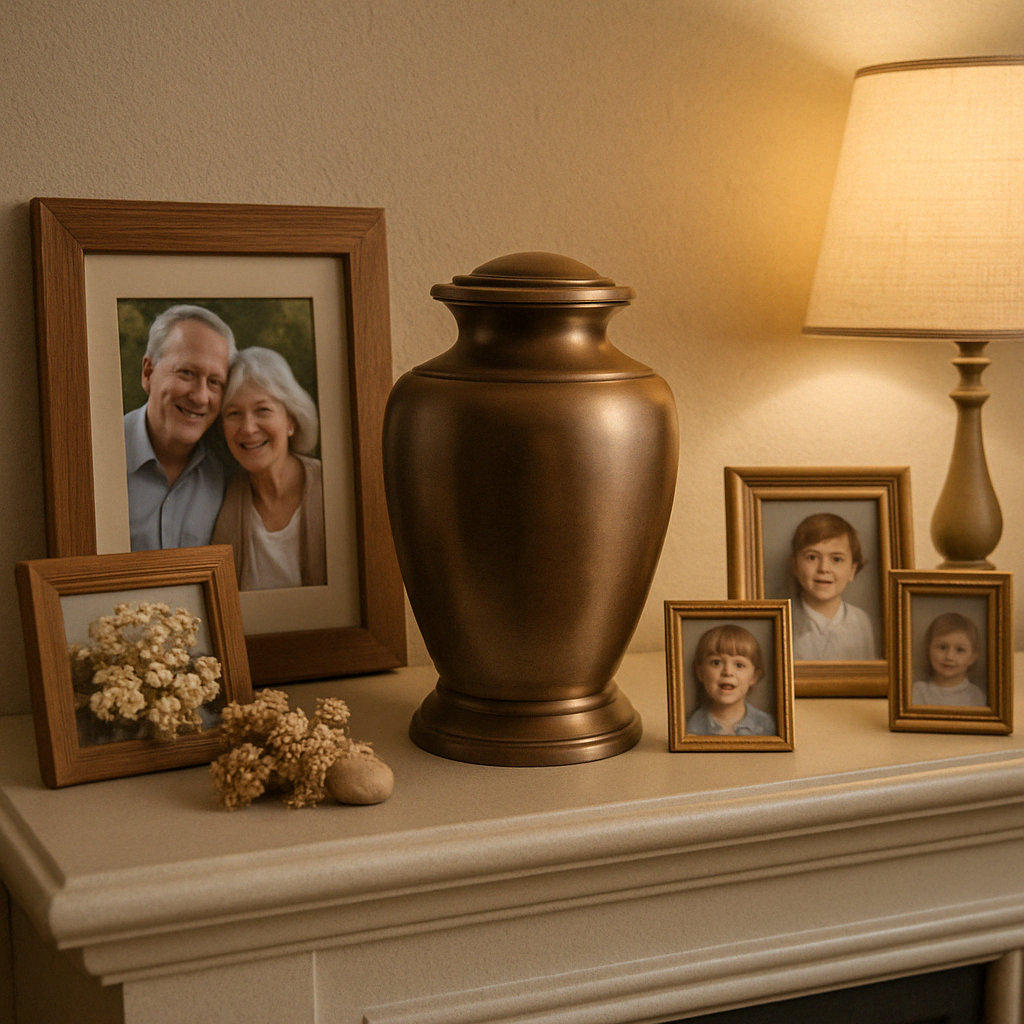
Caring for Your Urn
Different urn materials need different kinds of attention to keep them looking their best over the years. With proper care, your ashes in a urn memorial can remain beautiful for generations.
For metal urns, regular dusting with a soft cloth is usually sufficient. Brass or bronze pieces benefit from an occasional polish with a specialized metal cleaner, though some families appreciate the natural patina that develops over time. Bronze urns in particular may need annual beeswax treatments to maintain their finish.
Wooden urns require gentle care to preserve their warmth and luster. Dust them regularly with a soft cloth and occasionally treat them with an appropriate wood polish or oil as recommended by the manufacturer. Keep wooden urns away from direct sunlight and maintain consistent humidity levels to prevent the wood from drying or warping.
If you've chosen a ceramic or glass urn, handle it with clean hands to avoid transferring oils that attract dust. For cleaning, use only a very soft cloth to prevent scratching, and if fingerprints appear, a slightly damp cloth followed by immediate drying works well. Never use abrasive cleaners on these more delicate materials.
Stone urns like marble or granite have their own care requirements. For daily maintenance, a simple dusting with a soft cloth is sufficient. When deeper cleaning is needed, a slightly damp cloth works well for granite, while marble might benefit from an annual application of stone sealer to protect its more porous surface.
One customer shared about their marble-painted aluminum urn: "We keep it on our mantel with a small framed photo. The urn looks neat and doesn't immediately read as a cremation container to visitors, which we appreciate. It's become a beautiful, subtle memorial."
With thoughtful placement and proper care, an urn can become not just a container for ashes in a urn, but a meaningful touchstone in your home – a quiet reminder of love that continues even after loss.
Alternative Ways to Handle Ashes After Cremation
When it comes to honoring a loved one's memory, traditional urns aren't the only option. Many families today are exploring creative and meaningful alternatives that better reflect their loved one's personality or allow multiple family members to share in the memorial experience.
Keepsake Urns
Keepsake urns offer a beautiful solution for families who wish to share their loved one's presence across different households or locations. These miniature versions of traditional urns typically hold between 1-50 cubic inches of ashes in a urn, just enough for a meaningful memorial without requiring the full remains.
"Having a small keepsake urn let each of my siblings keep a part of Mom with them," shares Melissa, who divided her mother's ashes among four children. "We're spread across the country, but we all have a physical connection to her."
These smaller urns come in the same variety of materials as their full-sized counterparts—metals, wood, ceramic, and glass—but their compact size makes them more portable and often more affordable. They're perfect for dividing ashes among family members, creating smaller memorials in meaningful locations, or keeping a portion at home while scattering the remainder elsewhere.
Cremation Jewelry
For those seeking an even more personal connection, cremation jewelry offers a way to keep a tiny portion of your loved one close throughout daily life. These intimate memorials come in various forms, from neat pendants worn as necklaces to sophisticated rings with small compartments. Some people find comfort in bracelets with hollow charms, while others prefer the artistry of glass pieces with ashes actually fused into the material during creation.
The beauty of cremation jewelry lies in its discretion—most pieces appear simply as lovely accessories to others, while holding profound meaning for the wearer. This option has grown increasingly popular as people find the comfort of maintaining a physical connection with their loved one wherever they go.
Scattering Ashes
Many families feel drawn to return their loved ones to meaningful natural settings through ash scattering ceremonies. Whether it's a favorite fishing spot, a beloved mountain vista, or simply the family garden, releasing ashes in a urn to the elements can provide profound closure.
Before planning a scattering, it's important to consider a few practical aspects:
- Check local regulations, as some areas require permits
- Pay attention to wind direction to ensure a dignified experience
- Plan meaningful words or music to accompany the moment
- Consider using a specially designed scattering urn that makes the process more graceful
After scattering, many families wonder what to do with the empty urn. Some repurpose it as a memory container for photos or mementos, while others transform it into a flower vase if the material is suitable. Some simply keep it as a memorial object, while others choose to donate it to someone in need.
For more creative ideas, you might find inspiration in Things You Can Do with an Urn After Scattering the Ashes.
Biodegradable Urns for Environmentally Friendly Ash Storage
For those who cherished nature during life, biodegradable urns offer a meaningful way to return to the earth with minimal environmental impact.
Environmental Benefits
Choosing a biodegradable urn aligns with values of environmental stewardship while providing a beautiful final tribute. These urns naturally break down when buried or placed in water, offering several advantages over traditional options. They reduce environmental impact by avoiding permanent materials, don't require perpetual cemetery maintenance, and allow for a natural return to the earth's cycles—something many environmentally-conscious individuals would appreciate.
"My husband was an avid gardener and environmentalist," recalls Joanne from Oregon. "Using a biodegradable urn that would help grow a new tree felt like the perfect way to honor his values and keep his memory alive in a literal, growing way."
Types of Biodegradable Urns
The market for eco-friendly memorial options has blossomed in recent years, with several thoughtful approaches to ashes in a urn that eventually return to nature:
Tree Urns combine cremated remains with specialized soil and a tree seedling, creating living memorials that grow more beautiful with each passing year. These innovative systems are designed to neutralize the naturally high pH of ashes to support healthy tree growth, changing loss into new life.
Water Urns are crafted from materials like salt, sand, or gelatin-based compounds that gently dissolve when placed in water. This allows ashes to disperse naturally in oceans, lakes, or rivers—perfect for someone who felt a deep connection to water during their lifetime.
Soil Urns made from recycled paper, bamboo, or natural clay break down when buried, returning the ashes in a urn to the earth with minimal environmental impact. These are ideal for garden burials or natural burial grounds.
Flower Pot Urns blend memorial and gardening by combining a biodegradable container with flower seeds or small plants. These create living memorials that bloom season after season, bringing vibrant color and life as a testament to your loved one's memory.
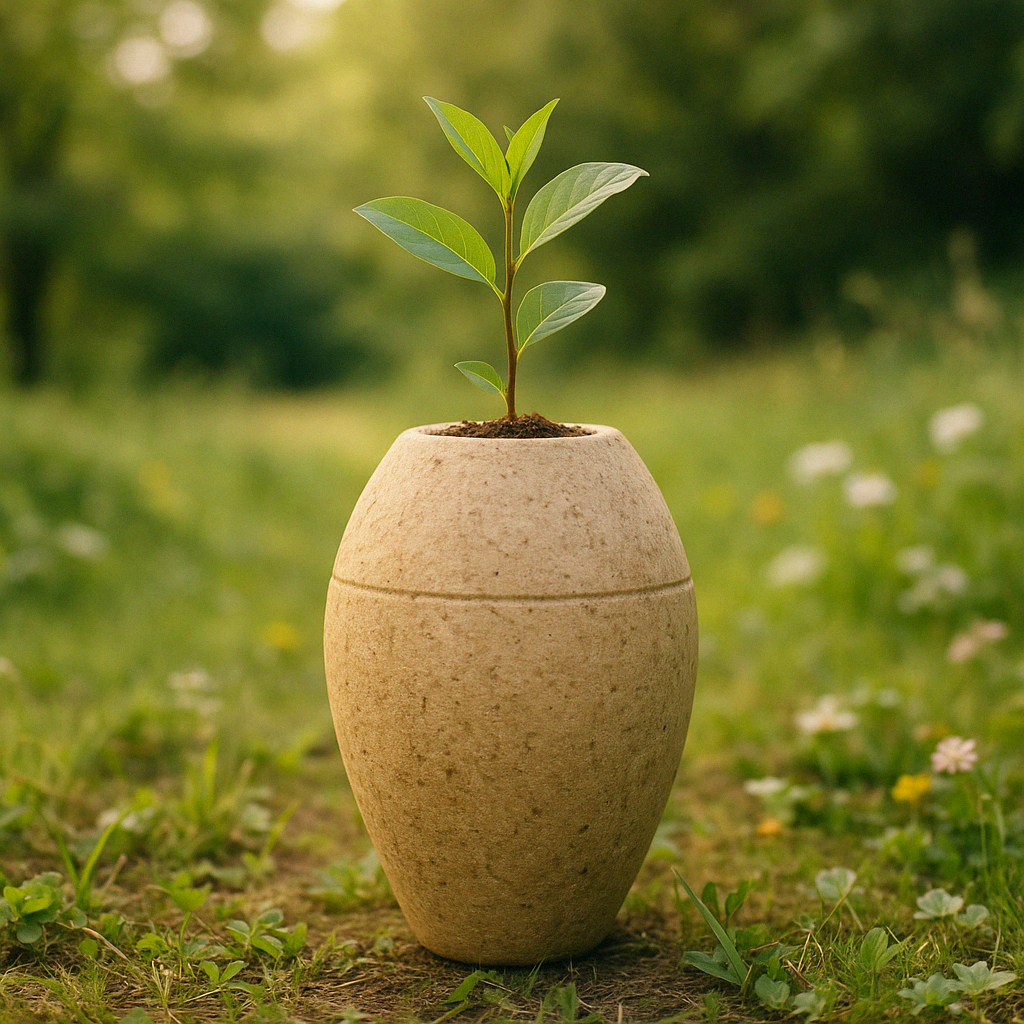
One particularly thoughtful option is the Living Urn system, which offers over fifty tree species options custom to your specific region. By simply entering your zip code, you can find which tree species will thrive in your area, ensuring your living memorial flourishes for generations to come.
For a deeper exploration of these environmentally conscious options, visit our comprehensive guide: Ashes to Earth: The Complete Guide to Biodegradable Urns.
Frequently Asked Questions about Ashes in a Urn
Can I Open and Seal a Cremation Urn Myself?
Yes, most cremation urns are designed with family members in mind, making it possible for you to open and seal them yourself. The process is usually straightforward, though it varies depending on your specific urn.
If you have a traditional urn with a threaded top, you'll simply unscrew the lid counterclockwise to open it. When it's time to seal it again, align the threads carefully and turn clockwise until it feels secure—but be gentle, as over-tightening isn't necessary and could damage some urns.
Some more decorative urns have bottom openings instead. Look for a felt circle on the bottom that can be removed to reveal either screws or a threaded plate. With a screwdriver, you can remove these fasteners, fill the urn, and then replace and secure them.
When it comes to sealing, you have options. Most urns can be temporarily sealed just by closing them properly, which many families prefer as it allows access later if needed. For a permanent seal, a small amount of adhesive around the seam works well—but do take a moment to consider whether you might need to open the urn in the future before choosing this route.
There's no pressure to handle this task yourself. If you find the process emotionally difficult or physically challenging, funeral homes and crematoriums typically offer assistance with transferring and sealing ashes in a urn as a courtesy service.
Is it Safe to Keep Ashes in a Urn at Home?
Absolutely—keeping cremated remains at home is completely safe. The cremation process subjects remains to temperatures around 1,800°F, making the resulting ashes sterile and free from any health concerns. That said, there are a few practical things to keep in mind.
Physical safety is worth considering, especially if you have a tall urn or one made of more delicate materials like ceramic or glass. Find a stable surface where your urn won't be easily knocked over—perhaps a mantle, bookshelf, or dedicated memorial space.
The emotional aspect of keeping ashes in a urn at home varies from person to person and family to family. Some find tremendous comfort in having their loved one's presence nearby, while others might find it makes moving forward more difficult. Having open, honest conversations about where and how to display the urn ensures everyone's feelings are respected.
From a legal perspective, there's good news—in the United States and most countries, there are no restrictions on keeping cremated remains at home. The only exception might be if you plan to transport the ashes internationally, which sometimes requires specific documentation.
It's also wise to think about long-term plans for the ashes. Many families include instructions in their wills or funeral plans about what should eventually happen to ashes kept at home, providing peace of mind for everyone involved.
What Should I Do with the Urn After Scattering the Ashes?
After scattering your loved one's ashes, you might wonder what to do with the empty urn. This vessel likely holds its own sentimental value, and there are several meaningful ways to give it new purpose.
Many families transform the urn into a keepsake container for mementos. Photos, letters, jewelry, or small belongings that remind you of your loved one can create a beautiful memory box that continues to honor their life in a new way.
If the material is suitable (most ceramic, metal, and some wooden urns work well), the vessel can find new life as a flower vase. Some families find it especially meaningful to grow their loved one's favorite flowers or plants in what was once their final resting place.
Another heartfelt option is to donate the urn to someone in need. Through funeral homes, churches, or community groups, your urn could help another family during their time of grief while easing their financial burden.
Some families choose to keep the urn for future use, especially if other family members have expressed interest in cremation. This approach can be both practical and a way of maintaining family connections across generations.
If none of these options feel right, respectful disposal is always an option. Some families bury the empty urn or include it in a small private ceremony that marks the transition to a new phase of remembrance.
One family shared their experience: "After scattering Mom's ashes in her garden, we decided to use her beautiful ceramic urn as a vase for fresh flowers on our dining table. Every time we see those blooms, we think of her love for gardening. It feels like she's still joining us for family dinners in a way."
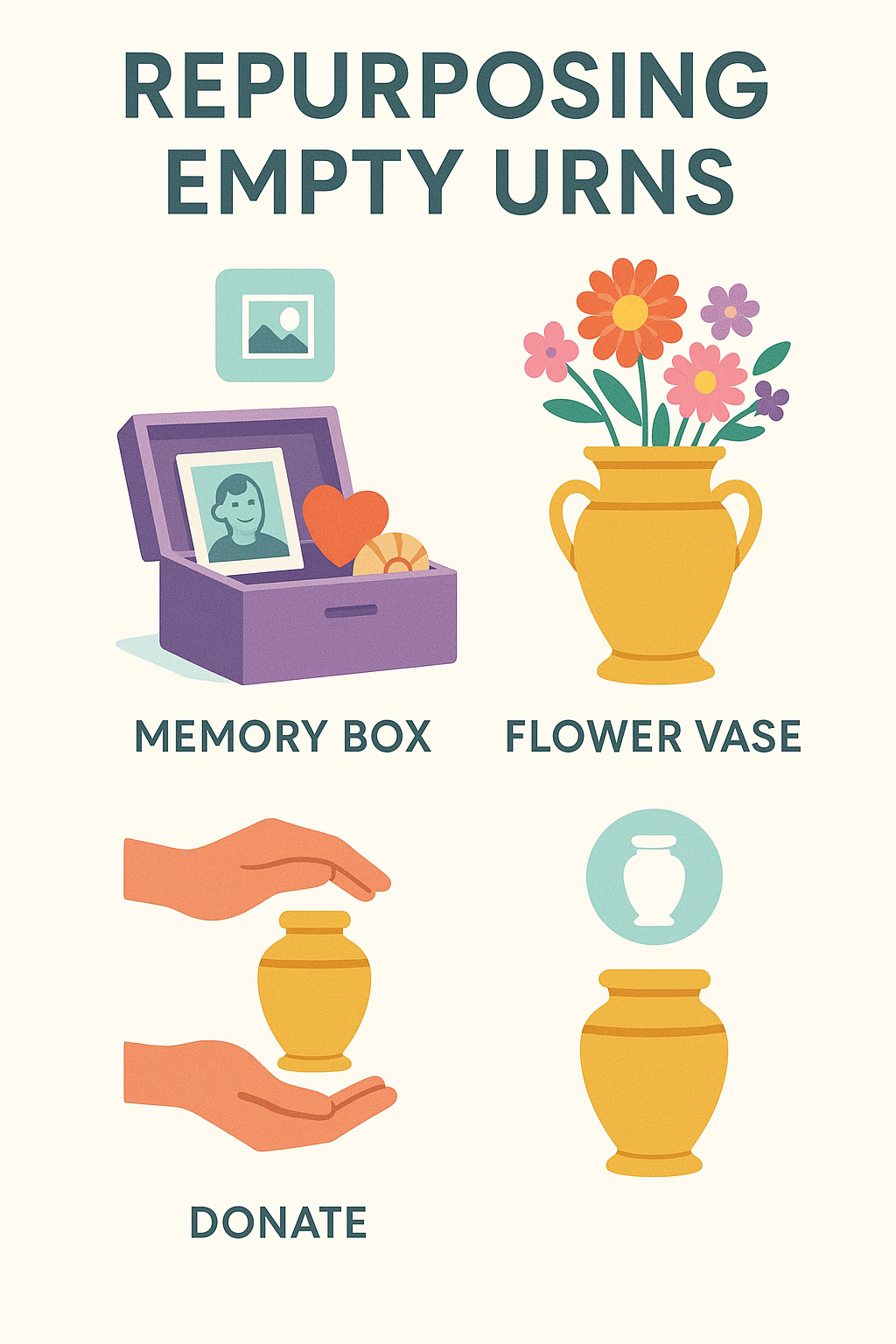
Finding the right way to repurpose an urn is deeply personal—there's no single right answer. What matters most is choosing an option that brings you comfort and honors your loved one's memory in a way that feels authentic to who they were and what they meant to you.
Conclusion
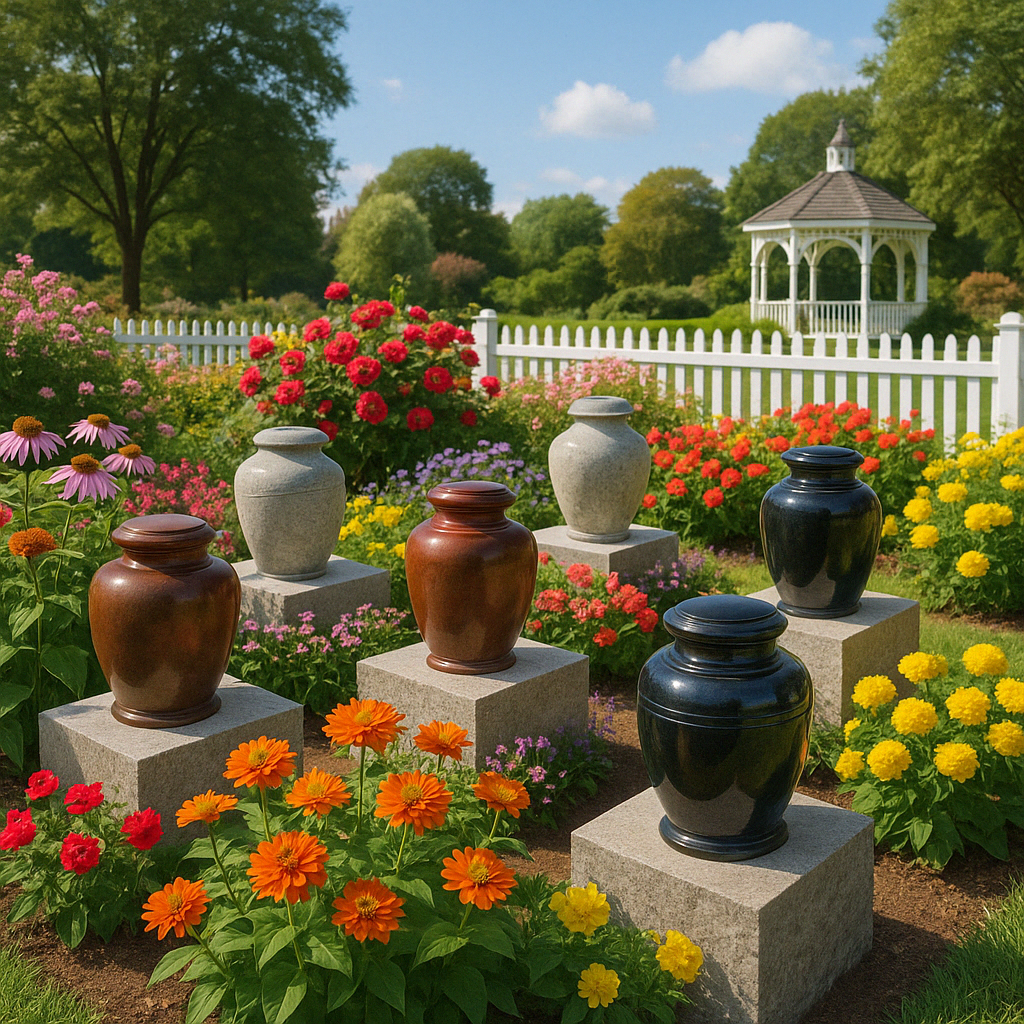
The journey of storing ashes in a urn touches our hearts in profound ways. It's not just about finding a container—it's about creating a lasting tribute that honors someone deeply loved. Throughout our lives, we celebrate birthdays, anniversaries, and achievements together. Now, this final act of care becomes part of your story with them.
I've seen families find unexpected comfort in the simple act of choosing the perfect urn—one that captures a personality, a passion, or a shared memory. Whether you've selected a hand-carved wooden vessel that reminds you of dad's workshop, or a ceramic piece in mom's favorite shade of blue, these choices matter. They help us process our grief while celebrating the unique life that touched ours.
There's no rush in this process. Take your time with each decision, from selecting an urn that fits both practically and emotionally, to considering whether you'll transfer the ashes yourself or ask for assistance. Many find the transfer becomes a meaningful ritual when approached with care, while others prefer to have professionals handle this step—both choices honor your loved one equally well.
Your home display can be as unique as your relationship was. Some families create special shelves with photographs and mementos, while others prefer a simpler approach with the urn itself as the focal point. What matters is that the space brings you comfort rather than sadness as time passes.
Beyond traditional urns, many families now find meaning in alternative memorials. From keepsake jewelry that keeps a loved one close throughout your day, to biodegradable options that transform grief into new life, these choices reflect our changing relationship with remembrance. As one family told me after planting a tree urn, "Watching something beautiful grow from our loss has helped us more than we ever expected."
Whatever path you choose, be gentle with yourself and others involved. Grief doesn't follow a timetable, and what feels right for one person might not resonate with another. The true measure of a memorial isn't its cost or appearance, but how it helps you carry your loved one's memory forward in a way that brings peace.
For those seeking additional guidance on selecting the perfect cremation urn, our detailed resource can help: The Complete Guide to Choosing Cremation Urns
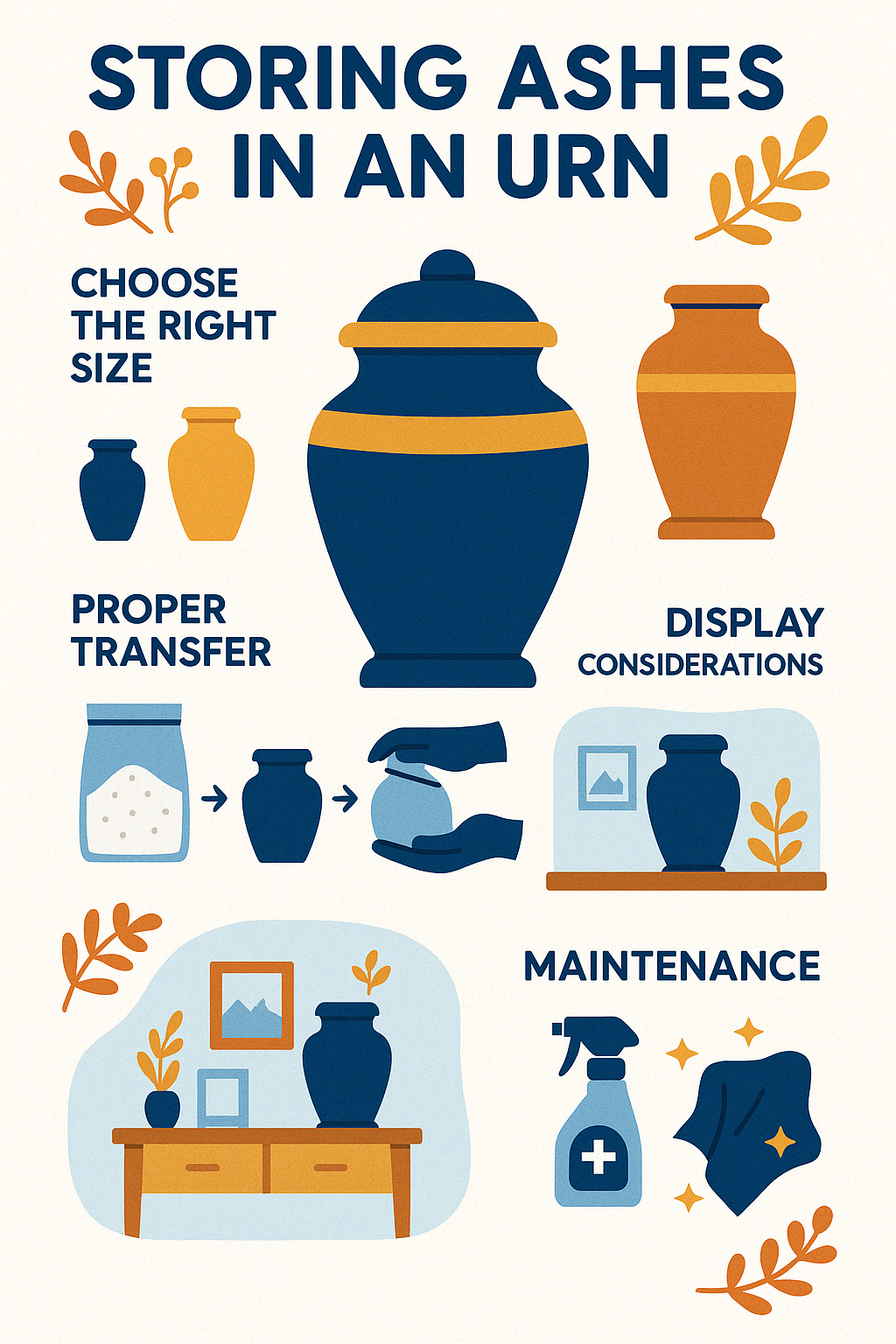
About American Mortuary Coolers
At American Mortuary Coolers, we understand the importance of dignity and respect in all aspects of memorial services. Based in Tennessee with locations across the United States including Johnson City TN, Atlanta GA, Chicago IL, Columbia SC, Dallas TX, Los Angeles, New York NY, and Pittsburgh PA, we specialize in crafting custom mortuary coolers and related equipment for the funeral industry.
While our primary focus is providing durable, custom cooling solutions for funeral homes and crematoriums, we're committed to supporting families through every stage of the memorial process. Our team serves the Midwest, Northeast, Rocky Mountain, Southeast, Southwest, and Pacific regions with direct delivery across the contiguous 48 states.
We believe that proper education about all aspects of memorialization helps families make informed decisions during difficult times. Whether you're a funeral professional or a family member seeking guidance, we're here to provide the information and support you need.
For more information about our products and services, please contact our team. We're committed to serving the funeral industry with respect, dignity, and the highest quality equipment available.


